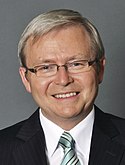
Back ھەڵبژاردنی فیدراڵیی ئوسترالیا (٢٠٠٧) CKB Parlamentswahl in Australien 2007 German Αυστραλιανές ομοσπονδιακές εκλογές 2007 Greek Elecciones federales de Australia de 2007 Spanish انتخابات فدرال استرالیا (۲۰۰۷) Persian Élections fédérales australiennes de 2007 French Elezioni parlamentari in Australia del 2007 Italian 2007년 오스트레일리아 의회 선거 Korean Australische parlementsverkiezingen 2007 Dutch Valget i Australia 2007 NB
| ||||||||||||||||||||||||||||||||||||||||
All 150 seats in the House of Representatives 76 seats were required for a majority in the House 40 (of the 76) seats in the Senate | ||||||||||||||||||||||||||||||||||||||||
|---|---|---|---|---|---|---|---|---|---|---|---|---|---|---|---|---|---|---|---|---|---|---|---|---|---|---|---|---|---|---|---|---|---|---|---|---|---|---|---|---|
| Registered | 13,646,539 | |||||||||||||||||||||||||||||||||||||||
| Turnout | 12,930,814 (94.72%) ( | |||||||||||||||||||||||||||||||||||||||
| ||||||||||||||||||||||||||||||||||||||||
 Results by division for the House of Representatives, shaded by winning party's margin of victory. | ||||||||||||||||||||||||||||||||||||||||
| ||||||||||||||||||||||||||||||||||||||||
2007 Australian federal election |
|---|
| National results |
| State and territory results |
The 2007 Australian federal election was held in Australia on 24 November 2007. All 150 seats in the House of Representatives and 40 of the seats in the 76-member Senate were up for election. The election featured a 39-day campaign, with 13.6 million Australians enrolled to vote.[1]
The centre-left Australian Labor Party opposition, led by Kevin Rudd and deputy leader Julia Gillard, defeated the incumbent centre-right Coalition government, led by Liberal Party leader and Prime Minister, John Howard, and Nationals leader and Deputy Prime Minister, Mark Vaile, by a landslide. The election marked the end of the 11 year Howard Liberal-National Coalition government that had been in power since the 1996 election.[2] This election also marked the start of the six-year Rudd-Gillard Labor government.
Future Prime Minister Scott Morrison, future opposition leader Bill Shorten and future Deputy Prime Minister Richard Marles entered parliament at this election. This would be the last time the Labor Party would win a majority at the federal level until the 2022 election. This remains the most recent election in which both major parties won over 40% of first preference votes.
Rudd became the third Labor leader after World War II to lead the party to victory from opposition, after Gough Whitlam in 1972, Bob Hawke in 1983, and before most recently Anthony Albanese in 2022.
Although the Coalition was defeated, the results in Western Australia bucked the national trend. While there was a swing against the Liberal Party and to the Labor Party, which allowed Labor to gain the seat of Hasluck from the Liberals, the Liberals managed to gain the seats of Cowan and Swan from Labor.
- ^ "Gazetted Enrolment as at 31 October 2007" (Press release). Australian Electoral Commission. 15 November 2007. Retrieved 23 May 2010.
- ^ "State of the parties". Australia Votes 2007. ABC Online. Archived from the original on 22 October 2007. Retrieved 25 November 2007.
© MMXXIII Rich X Search. We shall prevail. All rights reserved. Rich X Search

